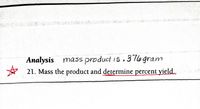
Chemistry
10th Edition
ISBN: 9781305957404
Author: Steven S. Zumdahl, Susan A. Zumdahl, Donald J. DeCoste
Publisher: Cengage Learning
expand_more
expand_more
format_list_bulleted
Concept explainers
Question
How do you determine percent yield? Is there a formula?

Transcribed Image Text:Analysis mass product is.37o gram
21. Mass the product and determine percent yield..
Expert Solution
This question has been solved!
Explore an expertly crafted, step-by-step solution for a thorough understanding of key concepts.
Step by stepSolved in 2 steps

Knowledge Booster
Learn more about
Need a deep-dive on the concept behind this application? Look no further. Learn more about this topic, chemistry and related others by exploring similar questions and additional content below.Similar questions
- Seven pleasearrow_forwardStarting with 1.56g of salicylic acid, a student prepares 1.75g of aspirin. If the theoretical yield of aspirin is 1.88g, what is the percent yield?arrow_forward1.71 g H2 is allowed to react with 9.66 g N2, producing 1.01 g NH3.What is the percent yield for this reaction under the given conditions? Express your answer to three significant figures and include the appropriate units.arrow_forward
- True or False? A molar ratio is a ratio between the number of moles of any two components involved in a chemical reaction.arrow_forwardThe actual yield of one of the reactions in 43.5g. What was theoretical yield in the laboratory if the scientist concluded that % yield of the reaction ended up to be 77%.arrow_forwardA student performed a chemical reaction that had calculated theoretical yield of 35.0grams. However, the student measured an actual yield of 32.5 grams. Calculate the percent yield?arrow_forward
- my theoretical yield was 45.0g. If my percent yield was 68.0%, how much was my actual yield?arrow_forward1) The Law of Conservation of Mass states that the total mass, in an open system, does not change as the result of reactions between its parts. True False 2) The deviation from the theoretical yield to the actual yield is called the percent yield. True Falsearrow_forwardWhat does the percent yield mean in describing chemical reactions and why is it not exactly 100%?arrow_forward
- DDT, which can be prepared by the reaction shown below, was an insecticide used to prevent mosquito borne diseases. Due to the harmful effects on birds and fish, it is now banned in the US. However, other countries still use it to control mosquitos. Determine the amount of DDT that can be produced and the percent yield for this reaction by constructing a BCA table, determining the maximum grams of DDT that can be produced, and calculating the percent yield. Complete Parts 1-3 before submitting your answer. 1 Before (mol) Change (mol) After (mol) 2 C₂H₂CI+ C₂HOCI → C₁H₂Cl + H₂O 3 14 9 5 2 3 NEXT > If a company in South America started with 1175 g of chlorobenzene (CH₂CI, MW 112.55 g/mol) and 538.5 g of chloral (C₂HOCI, MW 147.39 g/mol), set up the table below that represents 100% yield with the given reaction conditions. 2 C₂H₂CI + C₂HOCI CH.CI 14 9 5 + H₂Oarrow_forwardCalculate percent yield and theoretical yield Benzophenone starting mass was 1.272g and after the experiment was over I got 0.1944garrow_forwardHow do you determine percent yield given 9.13 mL benzyl alcohol gives 8.58 mL benzaldehyde?arrow_forward
arrow_back_ios
arrow_forward_ios
Recommended textbooks for you
 ChemistryChemistryISBN:9781305957404Author:Steven S. Zumdahl, Susan A. Zumdahl, Donald J. DeCostePublisher:Cengage Learning
ChemistryChemistryISBN:9781305957404Author:Steven S. Zumdahl, Susan A. Zumdahl, Donald J. DeCostePublisher:Cengage Learning ChemistryChemistryISBN:9781259911156Author:Raymond Chang Dr., Jason Overby ProfessorPublisher:McGraw-Hill Education
ChemistryChemistryISBN:9781259911156Author:Raymond Chang Dr., Jason Overby ProfessorPublisher:McGraw-Hill Education Principles of Instrumental AnalysisChemistryISBN:9781305577213Author:Douglas A. Skoog, F. James Holler, Stanley R. CrouchPublisher:Cengage Learning
Principles of Instrumental AnalysisChemistryISBN:9781305577213Author:Douglas A. Skoog, F. James Holler, Stanley R. CrouchPublisher:Cengage Learning Organic ChemistryChemistryISBN:9780078021558Author:Janice Gorzynski Smith Dr.Publisher:McGraw-Hill Education
Organic ChemistryChemistryISBN:9780078021558Author:Janice Gorzynski Smith Dr.Publisher:McGraw-Hill Education Chemistry: Principles and ReactionsChemistryISBN:9781305079373Author:William L. Masterton, Cecile N. HurleyPublisher:Cengage Learning
Chemistry: Principles and ReactionsChemistryISBN:9781305079373Author:William L. Masterton, Cecile N. HurleyPublisher:Cengage Learning Elementary Principles of Chemical Processes, Bind...ChemistryISBN:9781118431221Author:Richard M. Felder, Ronald W. Rousseau, Lisa G. BullardPublisher:WILEY
Elementary Principles of Chemical Processes, Bind...ChemistryISBN:9781118431221Author:Richard M. Felder, Ronald W. Rousseau, Lisa G. BullardPublisher:WILEY

Chemistry
Chemistry
ISBN:9781305957404
Author:Steven S. Zumdahl, Susan A. Zumdahl, Donald J. DeCoste
Publisher:Cengage Learning

Chemistry
Chemistry
ISBN:9781259911156
Author:Raymond Chang Dr., Jason Overby Professor
Publisher:McGraw-Hill Education

Principles of Instrumental Analysis
Chemistry
ISBN:9781305577213
Author:Douglas A. Skoog, F. James Holler, Stanley R. Crouch
Publisher:Cengage Learning

Organic Chemistry
Chemistry
ISBN:9780078021558
Author:Janice Gorzynski Smith Dr.
Publisher:McGraw-Hill Education

Chemistry: Principles and Reactions
Chemistry
ISBN:9781305079373
Author:William L. Masterton, Cecile N. Hurley
Publisher:Cengage Learning

Elementary Principles of Chemical Processes, Bind...
Chemistry
ISBN:9781118431221
Author:Richard M. Felder, Ronald W. Rousseau, Lisa G. Bullard
Publisher:WILEY